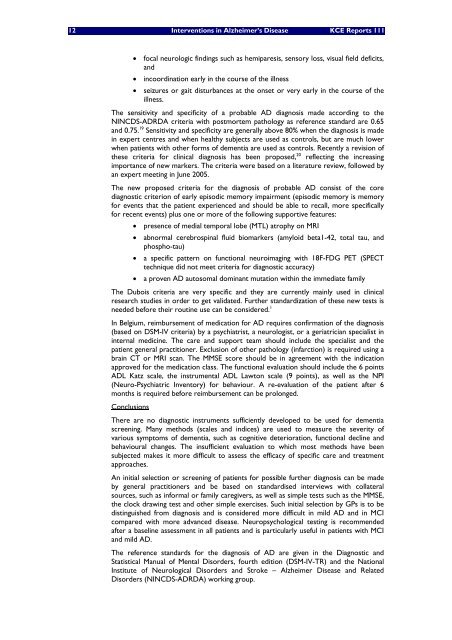Download the full report (112 p.) - KCE
Download the full report (112 p.) - KCE
Download the full report (112 p.) - KCE
Create successful ePaper yourself
Turn your PDF publications into a flip-book with our unique Google optimized e-Paper software.
12 Interventions in Alzheimer’s Disease <strong>KCE</strong> Reports 111<br />
• focal neurologic findings such as hemiparesis, sensory loss, visual field deficits,<br />
and<br />
• incoordination early in <strong>the</strong> course of <strong>the</strong> illness<br />
• seizures or gait disturbances at <strong>the</strong> onset or very early in <strong>the</strong> course of <strong>the</strong><br />
illness.<br />
The sensitivity and specificity of a probable AD diagnosis made according to <strong>the</strong><br />
NINCDS-ADRDA criteria with postmortem pathology as reference standard are 0.65<br />
and 0.75. 19 Sensitivity and specificity are generally above 80% when <strong>the</strong> diagnosis is made<br />
in expert centres and when healthy subjects are used as controls, but are much lower<br />
when patients with o<strong>the</strong>r forms of dementia are used as controls. Recently a revision of<br />
<strong>the</strong>se criteria for clinical diagnosis has been proposed, 20 reflecting <strong>the</strong> increasing<br />
importance of new markers. The criteria were based on a literature review, followed by<br />
an expert meeting in June 2005.<br />
The new proposed criteria for <strong>the</strong> diagnosis of probable AD consist of <strong>the</strong> core<br />
diagnostic criterion of early episodic memory impairment (episodic memory is memory<br />
for events that <strong>the</strong> patient experienced and should be able to recall, more specifically<br />
for recent events) plus one or more of <strong>the</strong> following supportive features:<br />
• presence of medial temporal lobe (MTL) atrophy on MRI<br />
• abnormal cerebrospinal fluid biomarkers (amyloid beta1-42, total tau, and<br />
phospho-tau)<br />
• a specific pattern on functional neuroimaging with 18F-FDG PET (SPECT<br />
technique did not meet criteria for diagnostic accuracy)<br />
• a proven AD autosomal dominant mutation within <strong>the</strong> immediate family<br />
The Dubois criteria are very specific and <strong>the</strong>y are currently mainly used in clinical<br />
research studies in order to get validated. Fur<strong>the</strong>r standardization of <strong>the</strong>se new tests is<br />
needed before <strong>the</strong>ir routine use can be considered. 1<br />
In Belgium, reimbursement of medication for AD requires confirmation of <strong>the</strong> diagnosis<br />
(based on DSM-IV criteria) by a psychiatrist, a neurologist, or a geriatrician specialist in<br />
internal medicine. The care and support team should include <strong>the</strong> specialist and <strong>the</strong><br />
patient general practitioner. Exclusion of o<strong>the</strong>r pathology (infarction) is required using a<br />
brain CT or MRI scan. The MMSE score should be in agreement with <strong>the</strong> indication<br />
approved for <strong>the</strong> medication class. The functional evaluation should include <strong>the</strong> 6 points<br />
ADL Katz scale, <strong>the</strong> instrumental ADL Lawton scale (9 points), as well as <strong>the</strong> NPI<br />
(Neuro-Psychiatric Inventory) for behaviour. A re-evaluation of <strong>the</strong> patient after 6<br />
months is required before reimbursement can be prolonged.<br />
Conclusions<br />
There are no diagnostic instruments sufficiently developed to be used for dementia<br />
screening. Many methods (scales and indices) are used to measure <strong>the</strong> severity of<br />
various symptoms of dementia, such as cognitive deterioration, functional decline and<br />
behavioural changes. The insufficient evaluation to which most methods have been<br />
subjected makes it more difficult to assess <strong>the</strong> efficacy of specific care and treatment<br />
approaches.<br />
An initial selection or screening of patients for possible fur<strong>the</strong>r diagnosis can be made<br />
by general practitioners and be based on standardised interviews with collateral<br />
sources, such as informal or family caregivers, as well as simple tests such as <strong>the</strong> MMSE,<br />
<strong>the</strong> clock drawing test and o<strong>the</strong>r simple exercises. Such initial selection by GPs is to be<br />
distinguished from diagnosis and is considered more difficult in mild AD and in MCI<br />
compared with more advanced disease. Neuropsychological testing is recommended<br />
after a baseline assessment in all patients and is particularly useful in patients with MCI<br />
and mild AD.<br />
The reference standards for <strong>the</strong> diagnosis of AD are given in <strong>the</strong> Diagnostic and<br />
Statistical Manual of Mental Disorders, fourth edition (DSM-IV-TR) and <strong>the</strong> National<br />
Institute of Neurological Disorders and Stroke – Alzheimer Disease and Related<br />
Disorders (NINCDS-ADRDA) working group.

















